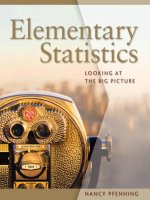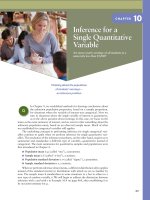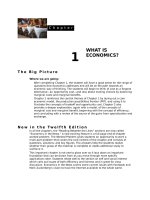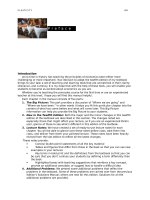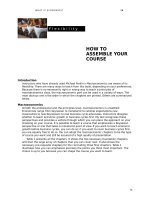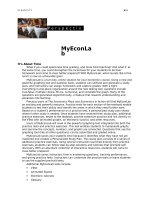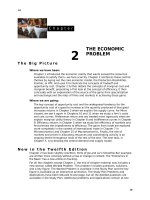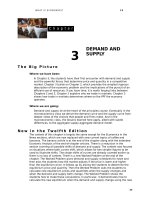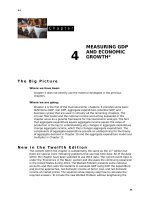The big picture marcoeconomics 12e parkin chapter 12
Bạn đang xem bản rút gọn của tài liệu. Xem và tải ngay bản đầy đủ của tài liệu tại đây (299.45 KB, 12 trang )
T H E B U S I N E S S C Y C L E , I N F L AT I O N , A N D D E F L A T I O N
C h a p t e r
1
2
THE BUSINESS
CYCLE, INFLATION
AND DEFLATION**
The Big Picture
Where we have been:
Chapter 12 uses the AS-AD model developed in Chapter 10 to explore business
cycles, inflation, and deflation. The distinction between the short-run and longrun aggregate supply curves is useful for appreciating the difference between
the short-run and long-run Phillips curves. Chapter 12 also draws on the
definition of inflation in Chapter 5.
Where we are going:
Chapter 12 is the last of three chapters dealing with macroeconomic
fluctuations. The explanation of the business cycle through the lens of the
aggregate supply-aggregate demand model lays the foundation for the next
two chapters, on fiscal policy and monetary policy respectively.
N e w i n t h e Tw e l f t h E d i t i o n
Along with the new title for the chapter, there is now a new section on deflation.
None of the other content was removed, but some sections were written more
concisely and the chapter was reorganized to move the business cycle section to
the beginning. The Economics In Action about the United States Phillips Curve was
shortened by including only data for the 2000’s. The end of chapter Economics In
The News feature has a 2014 article about the ECB’s attempts to fight stagnation
in the Eurozone. The Worked Problem covers demand-pull and cost-push inflation
issues. The Worked Problem gives aggregate demand and short-run aggregate
supply schedules and then asks the effect of changes in aggregate demand and
aggregate supply. It also asks what type of output gap is created. The answers use
both the data in the aggregate demand and short-run aggregate supply functions
as well as an aggregate supply/aggregate supply figure. To include the new
Worked Problem without lengthening the chapter, some problems have been
removed from the Study Plan Problem and Applications. These problems are still in
the MyEconLab and are called Extra Problems.
19
Lecture Notes
The Business Cycle, Inflation and Deflation
Explain how aggregate demand shocks and aggregate supply shocks create the
business cycle
Explain how demand-pull and cost-push forces bring cycles in inflation and output
Explain the causes and consequences of deflation
Explain the short-run and long-run tradeoff between inflation and unemployment
I. The Business Cycle
Business Cycles. Most principles of economics textbooks have a chapter that is similar
to this one. However, many of them contain an extended discussion to the effect that, “This
school of thought thinks this, but this other school of thought disagrees, and, by the way,
here’s a third school of thought that thinks the first school is partially correct but partially
wrong ...” This material is (appropriately enough!) found to be exceptionally tedious by the
students. Fortunately, Parkin’s chapter is not at all like these other weak attempts. Parkin
shows the students how the schools relate to each other and presents an incredibly
exciting chapter.
You can take advantage of this fact in your lecture by discussing with your students which
school of thought best describes your views and what evidence convinced you. Just as
students are always fascinated by why their instructor chose his or her field, so, too, are
students fascinated about where their instructor fits into the scheme of controversies that
they are learning about. By discussing your place in the line-up of different schools, be it
“hard-line” monetarist, or new Keynesian, or an eclectic mixture, you can be guaranteed of
your students’ strong interest when you discuss this topic.
You might also point out to the students that theories are not necessarily mutually
exclusive. For instance, even though you may be, perhaps, a monetarist, this does not
necessarily mean that you totally deny that the factors emphasized by real business cycle
proponents are occasionally important. By identifying your point of view and also giving
the students some instruction about your view as to the usefulness of the other
approaches, you can not only interest them but also help give them an enhanced general
understanding of macroeconomics.
Mainstream Business Cycle Theory
The mainstream business cycle theory regardless fluctuations in aggregate demand around
a growing potential GDP (and hence constantly rightward shifting LAS and SAS curves) as
the cause of the business cycle. Real GDP differs from potential GDP when money wage
rates do not offset changes in the price level.
Keynesian Cycle Theory: The Keynesian cycle theory asserts that fluctuations in
investment driven by fluctuations in business confidence—summarized by the
phrase “animal spirits”—are the main source of fluctuations in aggregate demand.
Money wage rates are assumed rigid.
Monetarist Cycle Theory: The monetarist cycle theory asserts that fluctuations in
both investment and consumption expenditure, driven by fluctuations in the growth
rate of the quantity of money, are the main sources of fluctuations in aggregate
demand. Money wage rates are assumed rigid.
New Classical Cycle Theory: The new classical cycle theory asserts that the
money wage rate and hence the position of the SAS curve are determined by the
rational expectation of the price level, which depends on potential GDP and expected
aggregate demand. Because the money wage rate changes with expected changes
in aggregate demand, only unexpected fluctuations in aggregate demand lead to
business cycle fluctuations.
New Keynesian Cycle Theory: The new Keynesian cycle theory asserts that
today’s money wage rates were negotiated at many past dates, which mean that
past rational expectations of the current price level influence the money wage rate
and the position of the SAS curve. Because the money wage rate does not change
with newly expected changes in aggregate demand, both expected and unexpected
fluctuations in aggregate demand lead to business cycle fluctuations.
Real Business Cycle Theory
The real business cycle theory (or RBC theory) regards random fluctuations in
productivity as the main source of economic fluctuations.
RBC Impulse: changes in the growth rate of productivity that results from
technological change. A decrease in productivity growth brings a recession and an
increase brings an expansion. Productivity shocks are measured using growth
accounting
The RBC Mechanism: A change in productivity changes investment demand and the
demand for labor.
If productivity falls, investment demand and hence the demand for loanabe fund
decreases. In addition, the demand for labor decreases. The decrease in the
demand for loanable funds means the real interest rate falls. According to RBC
theory, the fall in the real interest rate decreases the supply of labor because of
intertemporal substitution. Because both the supply of labor and the demand for
labor decrease, employment decreases and the change in the real wage rate is
small. Real GDP decreases.
Money plays no role in generating business cycles in the RBC theory; it affects only
the price level.
I like to motivate RBC theory by suggesting that economists, such as Lucas and Prescott,
challenged our previous portrayal of the LAS curve as being a stable curve that the short
run fluctuations revolve around. You can use your arm to suggest that the LAS curve itself
might shift leftward and rightward because of technology continuously impacting
productivity in unstable ways.
Criticisms and Defenses of Real Business Cycle Theory
Critics assert that money wages are sticky and that intertemporal substitution is too
weak to account for large fluctuations in the supply of labor, which are necessary for
RBC theory to explain the empirical fact that there are large fluctuations in
employment with only small fluctuations in the real wage rate.
A second criticism of RBC theory has to do with the direction of causality between
productivity and business cycle fluctuations. RBC theory assumes changes in
productivity cause business cycle fluctuations. Traditional aggregate demand
theories suggest that measures of productivity change as a result of business cycle
fluctuations. For instance, they assert that in expansions, capital and labor are used
more intensely so that measured productivity increases, even with no change in
technology.
What does it mean to use capital and labor more intensely? It is easy to see with labor
hours. A firm could record the same number of labor hours in an expansion as in a
recession. But, if the firm is trying to increase production to meet high demand in the
expansion, workers will work harder and, therefore, be more productive in the expansion.
This change in productivity is not related to technology but growth accounting likely will
(erroneously) attribute the increase in productivity to a technological advance.
122
CHAPTER 11
RBC theory defenders point out that the theory is consistent with microeconomic
evidence about labor supply decisions and labor demand and investment demand
decisions.
II. Inflation Cycles
Inflation is a process in which the price level is rising and money is losing value. Inflation is
not a rise in one price—it is a broad increase in the price level. Inflation also is not a onetime jump in the price level. It is an ongoing process.
There are many examples of one-time jumps in the price level that are not the same as
inflation. In Canada, when the federal sales tax was changed in the early 1990s, there was
a one-time increase in the CPI. Likewise, when the euro was introduced in 2001, there were
one-time increases in many prices in some countries. Neither of these events led to a
persistent rise in the rate at which the price level increased and measured inflation using
the CPI fell to previous levels soon after the one-time events.
Demand-Pull Inflation
An inflation that results from an initial increase in aggregate demand is called demandpull inflation. Any factor that increases aggregate demand, such as an increase in the
quantity of money, an increase in government expenditure, or an increase in exports, can
start a demand-pull inflation.
In the short run, an increase in aggregate
demand raises the price level and increases
real GDP. In the figure the aggregate demand
curve shifts from AD0 to AD1 so that the
economy moves from point a to point b and
the price level rises from 100 to 110.
Real GDP exceeds potential GDP and so in the
tight labor market the money wage rate
rises. The rise in the money wage rate
decreases short-run aggregate supply. In the
figure, the SAS curve shifts from SAS 0 to
SAS1. As a result, the economy moves from
point b to point c and the price level rises
even more, in the figure to 120. Real GDP
returns to potential GDP.
Inflation occurs only if aggregate demand continues to increase. And aggregate
demand continues to increase only if the quantity of money persistently increases.
Demand-Pull Inflation. The potential difficulty with both demand-pull and cost-push
inflation stories is how the one-time increase translates into an inflationary process. It is
relatively easy to come up with stories as to why aggregate demand might shift to the
right, for example because of persistent government budget deficits. (However
immediately tell the students that if the budget deficit does not constantly increase in size
relative to GDP, it will not lead to a constant increase in aggregate demand.) What is a
little harder is to provide a plausible story as to why the monetary authorities would
continue to accommodate the budget deficit with continuous increases in the quantity of
money. Point out that this has been rare in the United States, and has tended to happen
when the political situation was such that the Fed was not willing to be blamed for an
increase in unemployment. In other countries, particularly where the central bank is less
independent than in the United States, it has been more common for the central bank to
consistently monetize budget deficits.
Cost-Push Inflation
An inflation that results from an initial increase in costs is called cost-push inflation. The
two main sources of increases in costs are an increase in money wage rates or an increase
in the money prices of raw materials.
The cost hike decreases short-run
aggregate supply, which raises the
price
level and decreases real GDP. In the
figure
the short-run aggregate supply curve
shifts
from SAS0 to SAS 1 so that the
economy moves from point a to point
b and
the price level rises from 100 to 110.
The
combination of a rise in the price
level
and a fall in real GDP is called
stagflation.
One possible response to the
decrease in real GDP is for the Fed to
use
monetary policy to increase
aggregate demand. If the Fed
increases aggregate demand, real GDP increases and the price level rises still
higher. In the figure, this Fed policy shifts the aggregate demand curve from AD0 to
AD1 and the price level rises to 120.
Inflation occurs only if, in response to the higher price level, the force that initially
decreased aggregate supply recurs so that aggregate supply continues to decrease
and, at the same time, the Fed continues to increase aggregate demand.
Cost-Push Inflation. The text gives a good description of the first oil price increase in the
1970s as a cost-push inflation, and contrasts it well with the Fed’s refusal to accommodate
the second oil price increase in 1979. An explanation of how cost-push can be a more
widespread cause of inflation in other countries can be given in terms of countries where
labor is highly unionized, and in effect there are attempts by different interest groups to
obtain shares of GDP that add up to more than 100 percent, with accommodation by a
weak monetary authority. Such a process of repeated wage increases, inflation, and
monetary accommodation can give rise to continuing inflation. Analysts often “explain” the
cause of inflation by focusing attention on the good or service whose price increased the
most during the most recent time period. This is incorrect; inflation is the result of
monetary growth. To explain inflation, economists are looking for an explanation that fits
all cases not an explanation that focuses on specific prices of specific goods that differ
from one inflation to another.
Expected Inflation
When inflation is anticipated, the money wage rate changes to keep up with the
anticipated inflation. So when the AD curve shifts rightward, increasing the price
level, the money wage rate increases and the SAS curve shifts leftward. If the
increase in the price level is fully anticipated, then the money wage rate rises by the
same percentage so that the real wage rate remains constant. There are no
deviations from full employment. The magnitude of the shift in A D equals that in
SAS so that GDP remains equal to potential GDP and the economy moves up along
the LAS curve, from point a to point c in the figures above.
If inflation is not perfectly anticipated, the money wage rate changes but by a
different percentage than the price level. Some of the inflation is unanticipated, so
as a result the real wage rate changes and there are deviations from full
employment. If aggregate demand grows faster than anticipated, real GDP exceeds
potential GDP and the economy behaves as if it were in a demand-pull inflation. If
124
CHAPTER 11
aggregate demand grows slower than anticipated, real GDP is less than potential
GDP and the economy behaves as if it were in a cost-push inflation.
Because of the costs of unanticipated inflation, there are benefits to forming
accurate forecasts of inflation. The best available forecast is the one that is based on
all relevant information and is called a rational expectation.
III. Deflation
An economy experiences deflation when it has a persistently falling price level.
What Causes Deflation?
The starting point for understanding the cause of deflation is to distinguish between
a one-time fall in the price level and a persistently falling price level. A onetime fall
in the price level is not deflation. Deflation is a persistent and ongoing falling price
level.
The Quantity Theory and Deflation
The quantity theory of money explains the trends in inflation by focusing on the
trend influences on aggregate supply and aggregate demand. The foundation of the
quantity theory is the equation of exchange, which in its growth rate version and
solved for the inflation rate states:
Inflation rate = Money growth rate + Rate of velocity change - Real GDP growth rate
The quantity theory adds to the equation of exchange two propositions.
First, the trend rate of change in the velocity of circulation does not depend on
the money growth rate and is determined by decisions about the quantity of
money to hold and to spend.
Second, the trend growth rate of real GDP equals the growth rate of potential
GDP and, again, is independent of the money growth rate.
With these two assumptions, the equation of exchange becomes the quantity theory
of money and predicts that a change in the money growth rate brings an equal
change in the inflation rate.
What are the Consequences of Deflation?
The effects of deflation (like those of inflation) depend on whether it is anticipated or
unanticipated. But because inflation is normal and deflation is rare, when deflation occurs,
it is usually unanticipated.
Unanticipated deflation redistributes income and wealth, lowers real GDP and
employment, and diverts resources from production.
Workers with long-term wage contracts find their real wages rising. But
employers respond to a higher and rising real wage by hiring fewer workers, so
employment and output decrease.
With lower output and profits, firms re-evaluate their investment plans and cut
back on projects that they now see as unprofitable. This fall in investment slows
the pace of capital accumulation and slows the growth rate of potential GDP.
An Economics in Action explores the “Fifteen Years of Deflation in Japan.” The Economics in
Action feature describes how the deflation was unexpected, which decreased Japan’s
economic growth rate, and was the result of monetary growth that was kept too low.
How Can Deflation be Ended?
Deflation can be ended by removing its cause: The quantity of money is growing too
slowly. If the central bank ensures that the quantity of money grows at the target
inflation rate plus the growth rate of potential GDP minus the growth rate of the
velocity of circulation, then, on average,
Money Growth, Not the Quantity of Money
It takes an increase in the growth rate of the money stock, not a one-time increase in
the quantity of money, to end deflation.
Central banks sometimes increase the quantity of money and fail to increase its
growth rate.
IV. Inflation and Unemployment: The Phillips Curve
A Phillips curve shows the relationship between inflation and unemployment. There are
two time frames for a Phillips curve: the short run and the long run.
HISTORY NOTE: The Phillips Curve. As a description of how economics advances, I like
to give the students a stylized history of the Phillips curve. The story I tell starts in 1958
when A. W. Phillips published his empirical work. At that time the mainstream economic
model was quite different from the AS-AD model derived in the text. Essentially, it was
similar to the simple aggregate expenditure model presented in Chapter 11. He had British
data that covered a long period of time and so his results appeared to be a long run
phenomenon. The model was based on the assumption that the price level was constant,
making the inflation rate zero. This assumption was not too unrealistic immediately after
World War II. By 1955, however, the inflation rate began to creep higher and averaged 2.7
percent per year between 1956 and 1959. Inflation was beginning to be perceived as a
problem, one that a model with a “fixed price level assumption” was poorly suited to solve.
In this environment, economists gladly welcomed the simple, short-run Phillips curve, for it
gave them a handle on inflation. They believed that they could predict the unemployment
rate from their standard model and then combine this unemployment rate with the Phillips
curve to determine the resulting inflation rate. The vital assumption in this procedure is
that the Phillips curve captures a fixed tradeoff between the actual inflation rate and the
unemployment rate that is part of the economy’s structure.
This type of analysis reached its peak of popularity during the early and middle 1960s. By
1967, however, it was under attack. On a theoretical level, economist Milton Friedman—
among others—pointed out the flimsy justification behind the simple, fixed Phillips curve
assumption. On an empirical level, the simple, fixed Phillips curve failed as the inflation
rate rose toward the end of the 1960s and into the 1970s: the unemployment rate did not
fall as predicted by the fixed Phillips curve.
At this point the idea of a long-run Phillips curve (as distinct from the short-run one) was
developed. The concept that aggregate supply is an important component of
macroeconomics was taking hold, as was the idea that short-run Phillips curves shift
because of changes in people’s expectations. Thus the profession advanced significantly
between the initial discussion of the Phillips curve and what students learn today. This
advance was the result of the interaction between theory, suggesting that the idea of a
fixed short-run Phillips curve was inadequate, and empirical work that reinforced the point
that the simple, early approach was deficient.
126
CHAPTER 11
The Short-Run Phillips Curve
The short-run Phillips curve (SRPC)
shows the relationship between the
inflation rate and the unemployment rate
holding constant the expected inflation
rate and the natural unemployment rate.
The figure shows a short-run Phillips
curve. Inflation and unemployment have
a
negative relationship in the short run, so
moving along a short-run Phillips curve, a
higher inflation rate (holding constant the
expected inflation rate) leads to lower a
unemployment rate.
The downward sloping short-run Phillips
curve is equivalent to the upward sloping
short-run aggregate supply curve. When
aggregate demand unexpectedly
increases so that real GDP and the price level both unexpectedly rise, the increase in
real GDP lowers the unemployment rate and the unexpectedly higher price level
means there is unexpectedly high inflation. The short-run Phillips curve captures the
relationship between the lower unemployment rate and higher inflation rate.
Use the board to create a scatter plot of observations that allow you to later “statistically
fit” a line through the points as the Phillips curve. As you make the points on the graph,
you can call them out as different years from 1950-1969. Now discuss how policy-makers
embraced this model as getting to choose where they want to be on the Phillips curve. You
can motivate this by picking two points and asking the students which one they thought
would be preferred, high inflation and low unemployment or vice versa.
As government started to think it could “fine-tune the economy,” we began to observe data
points that had high inflation and high unemployment. Was Phillips wrong? Ask the
students what might have happened and you may get someone to say it shifted! This
answer is, of course, correct. Economists started to explore the effect of expected inflation
as a factor that shifts the Phillips curve. You can now discuss the distinction between the
long-run and the sort-run Phillips curve.
The Long-Run Phillips Curve
The long-run Phillips curve (LRPC) shows
the relationship between the inflation rate
and the unemployment rate when the actual
inflation rate equals the expected inflation
rate. As illustrated in the figure, the long-run
Phillips curve is vertical at the natural
unemployment rate.
The short-run Phillips curve intersects the
long-run Phillips at the expected inflation
rate. In the figure the expected inflation rate
is equal to 4 percent.
In the long run, higher or lower inflation has
no effect on the unemployment rate. This
result is analogous to the conclusion from
the AS-AD model that in long run, a higher or
lower price level has no effect on real GDP,
which equals potential GDP so that the
economy is at full employment.
The Phillips curve and the AS-AD model: Students can become confused about the tie
between the Phillips curve and the aggregate supply/aggregate demand (AS-AD) model.
Although this relationship is nicely developed in the text, some students will remain
baffled. I do not think that a principles course is the appropriate place to derive the link
between the two in much detail. But I do think that my lectures are an appropriate place to
convey the idea of the relationship. Thus I point out that the vertical long-run aggregate
supply curve is analogous to the vertical long-run Phillips curve. If you graph the two side
by side, identify potential real GDP and the natural rate of unemployment on the two
graphs at the intersection of the long run curves and the horizontal axis. The point that the
long-run aggregate supply curve is vertical means that a higher price level has no effect
on real GDP and hence no effect on the unemployment rate. Similarly, the fact that the
long-run Phillips curve is vertical implies that a higher inflation rate has no effect on the
unemployment rate and hence no effect on real GDP. The analogy also carries over to the
short-run curves: the positively sloped short-run aggregate supply curve shows that in the
short-run an unexpected higher price level raises real GDP and thus lowers unemployment.
In the same way, the negatively sloped short-run Phillips curve demonstrates that in the
short-run an unexpected higher inflation rate lowers unemployment, thereby raising real
GDP. Students find that the two diagrams actually complement each other. I think that this
approach is preferable to having the two diagrams compete with each other!
Shifts of the Phillips Curves
A change in the expected inflation rate shifts the SRPC vertically upward or
downward by the amount of the change but has no effect on the LRPC.
A change in the natural unemployment rate shifts both the SRPC and the LRPC. An
increase in the natural rate shifts the SRPC and LRPC rightward by the amount of the
increase; a decrease shifts the curves leftward by the amount of the decrease.
The U.S. Phillips Curves
Because of changes in the expected inflation and the natural rate of unemployment, the
short-run Phillips curve has shifted around a lot over time so that there is no single obvious
negative relationship between inflation and unemployment.
The Economics in the News section analyzes the EBC’s response to potential deflation in
2014.
128
CHAPTER 11
Additional Problems
1.
2.
Has the U.S. economy experienced inflation or deflation during recent
recessions? Explain.
The spreadsheet provides information about
the economy in Argentina. Column A is the
year, Column B is real GDP in billions of 2000
pesos, and Column C is the price level.
a. In which years did Argentina experience
inflation? In which years did it experience
deflation (a falling price level)?
b. In which years did recessions occur? In
which years did expansions occur?
c. In which years do you expect the
unemployment rate was highest? Why?
d. Do these data show a relationship between
unemployment and inflation in Argentina?
1
2
3
4
5
6
7
8
9
10
11
12
A
1997
1998
1999
2000
2001
2002
2003
2004
2005
2006
2007
2008
B
277
288
278
276
264
235
256
279
305
331
359
384
C
105.6
103.8
101.9
102.9
101.8
132.9
146.8
160.4
174.5
198.0
226.1
267.7
Solutions to Additional Problems
1,
The United States has experienced inflation during recent recessions, though there
have been instances when the inflation rate fell during recessions. For instance in late
2008 the inflation rate fell as the economy moved into a recession. Inflation, however,
generally continued because aggregate demand continued to increase during the
recessions, though at a slower rate.
2. a. Argentina experienced inflation in 2000 and from 2002 through 2008. Argentina
experienced deflation in 1998, 1999, and 2001.
b. Argentina had recessions in 1999, 2000, 2001, and 2002. Argentina had expansions
in 1998 and 2003 through 2008.
c. The unemployment rate was probably high in all of the recessionary years. It was
probably the highest in 2000 and 2002 when the recessions were at their worst.
d. There is not a strong relationship between unemployment and inflation in the data.
The unemployment rate would likely have been higher in the recession years of
1999, 2000, 2001, and 2002. In 2000 Argentina experienced low inflation and 2002
Argentina experienced high inflation. In 1999 and 2001 Argentina experienced
deflation. But Argentina also experienced deflation 1998. So there is no consistent
relationship between either inflation and high unemployment or deflation and high
unemployment. There also is a similar lack of relationship between inflation and low
unemployment or deflation and low unemployment.
Additional Discussion Questions
11. Some economists claim that inflation is always a “monetary
phenomenon.” What do they mean by this claim and are they correct?
This claim points to the result that an on-going inflation requires the central
bank to constantly increase the quantity of money. In the absence of continual
monetary growth, the price level might rise but it would eventually stabilize.
The price level will continue to rise, which means that on-going inflation will
occur, only if the Federal Reserve constantly increases the quantity of money.
Because inflation requires constant growth in the quantity of money, inflation
can be thought of as a “monetary phenomenon.”
12. How can a higher price of oil create inflation? By itself a higher price of
oil cannot create inflation. Taken by itself a higher price of oil can lead to a
higher price level but after the adjustment is made to the higher price of oil,
the price level stops rising—that is, inflation stops. A higher price of oil can
lead to inflation only if the central bank “ratifies” it by increasing the quantity
of money. If the central bank, the Federal Reserve in the United States,
responds to the decrease in real GDP created by the higher price of oil by
increasing the quantity of money, then inflation can result. The increase in the
quantity of money will drive the price level still higher. In this situation oil
producers might respond by again boosting the price of oil. If the Fed responds
once again in turn, the process can continue indefinitely and a cost-push
inflation results.
13. What is the relationship between the short-run aggregate supply
curve and the short-run Phillips curve? Between the long-run
aggregate supply curve and the long-run Phillips curve? The short-run
aggregate supply curve and the short-run Phillips curve are closely related. If
aggregate demand increases, the economy moves upward along its short-run
aggregate supply curve so that the price level and real GDP both increase. The
rise in the price level means that inflation rises and the increase in real GDP
means that unemployment falls. The rise in the inflation rate combined with
the fall in the unemployment rate correspond to a movement upward along
the economy’s short-run Phillips curve. Similarly the long-run Phillips curve
and long-run aggregate supply curve also are closely related. In the long run
an increase in aggregate demand moves the economy upward along its longrun aggregate supply curve so that the price level rises and real GDP does not
change—it remains equal to potential GDP. The rise in the price level means
that the inflation rate rises and the result that real GDP remains equal to
potential GDP means that the unemployment rate remains equal to its natural
rate. The rise in the inflation rate combined with the unemployment rate
remaining equal to its natural rate correspond to a movement upward along
the economy’s long-run Phillips curve.
14. Suppose the expected and actual inflation rates are 7 percent and the
natural rate of unemployment is 6 percent. If the inflation rate falls to
5 percent while the expected inflation rate remains at 7 percent,
what happens to the unemployment rate? If the actual inflation rate falls
and the expected inflation rate does not change, the economy moves
downward along a short-run Phillips curve so that the unemployment rate
increases.
15. Suppose the expected and actual inflation rates are 7 percent and the
natural rate of unemployment is 6 percent. If the inflation rate falls to
5 percent and the expected inflation rate also falls to 5 percent, what
happens to the unemployment rate? If the actual inflation rate and the
expected inflation rate fall by the same amount, the economy moves
downward along its long-run Phillips curve so that the unemployment rate
does not change—it remains equal to the natural unemployment rate.
16. Suppose that the actual inflation rate is 7 percent and that the
economy is at the natural unemployment rate. If the Fed announces
that it is going to lower the inflation rate and people believe this
announcement (so that the decline in the inflation rate is not a
130
CHAPTER 11
surprise), what happens to the unemployment rate? Suppose that
people believe the Fed’s announcement and that the expected
inflation rate falls, but then the Fed keeps the inflation rate at 7
percent. Now what happens to the unemployment rate? If the Fed
follows through on its announcement, both the actual and expected inflation
rate fall by the same amount so that the unemployment rate remains equal to
its natural rate. However if the Fed actually does not lower the inflation rate,
then the actual inflation rate exceeds the expected inflation rate. In this case
the short-run Phillips curve shifts downward. The economy moves to a point on
its new short-run Philips curve at the unchanged inflation rate and the
unemployment rate falls.
17. How do you think recessions influence elections? Recessions have large
impacts on elections. If an election occurs during (or near) a recession, the
incumbent party suffers. This empirical result holds true for President Ford who
lost his reelection bid in 1976; President Carter who lost his reelection bid in
1980; President Bush who lost his reelection bid in 1992; and Senator McCain
who lost his election bid in 2008. All of these candidates were members of the
incumbent party and all faced election either near or during a recession.
President Obama’s re-election in 2012 was an unusual case in that the
economy was in recovery but unemployment was still high near 8 percent.
